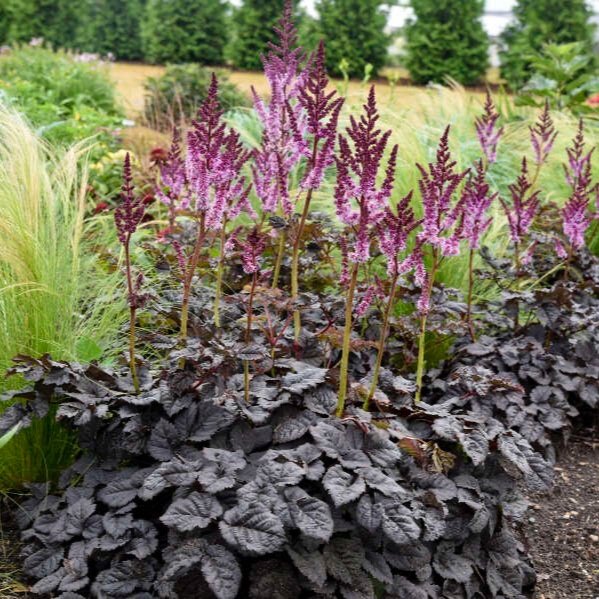A Dark Foliage Astilbe For the Sun or Shade
Cover image of Dark Side of the Moon Astilbe courtesy of Walters Gardens, Inc.
Meet Astilbe ‘Dark Side of the Moon’
Dark foliage astilbes make a dramatic statement in your garden and landscape.
Astilbe ‘Dark Side of the Moon’ may share its name with one of the greatest albums of all time, but while Pink Floyd’s masterpiece is a rock classic, this plant is destined to be a garden classic!
With its rich chocolate-brown foliage that emerges golden yellow and turns deep brown over time, this dark foliage astilbe brings irresistible depth to the landscape.
In midsummer, raspberry-pink flower plumes emerge and turn purple, creating a striking contrast against the dark foliage. A must-have for gardeners seeking texture and color, this variety is as easy to grow as it is eye-catching.
But Dark Side of the Moon astilbe isn’t just about good looks—it’s also a gardener’s dream. Deer and rabbits give it a hard pass, while bees happily flock to its nectar-rich blooms.
Thriving in full sun to shade and moist soil, this astilbe with dark foliage is perfect for borders, woodland gardens, and even containers.
Whether you’re after dramatic contrast or a reliable, easy-care perennial, this plant hits all the right notes. Let’s take a closer look at how and where to grow this future garden legend.
This blog is reader-supported and contains affiliate links. If you purchase a product using one of these links, I may earn a small commission at no extra cost to you. Thank you for your support!
The dark foliage Astilbe ‘Dark Side of the Moon’. Image courtesy of Walters Gardens, Inc.
How to Plant and Grow Astilbe ‘Dark Side of the Moon’
Location: Astilbe Dark Side of the Moon grows in sun to shade and is happiest when grown in partial, filtered sunlight. Ensure the soil is rich, moist, loose and well-draining. Astilbes prefer slightly acidic soil.
Planting: Plant this dark foliage astilbe in the spring or fall, and space 12 to 14 inches apart on center (12-14 inches from the center of one plant to the center of the next plant). Try this handy plant calculator to determine the number of plants required for your garden. Keep in mind that garden centers have the best selection in spring, so shop early to avoid disappointment!
Watering: Keep the soil consistently moist, especially during the first growing season. Astilbes prefer consistently damp conditions (for watering guidance, see “How to Water your Plants”). Water deeply and regularly, especially during the heat of summer and times of drought. Are you in a drought? Check the US Drought Monitor.
Mulching: Apply a layer of mulch around the plants to help retain soil moisture and suppress weeds. This is particularly important for moisture-loving astilbes!
Fertilizing: Create the organically rich, moisture retentive soil astilbes love by amending the soil with compost or garden manure. Adding a slow-release, organic fertilizer (such as Holly-tone) will increase the flowering display and help to create the acidic soil astilbes prefer.
Division: Dark Side of the Moon Astilbe can be divided every 3-4 years to maintain plant health and vigor. Divide in early spring before new growth begins or in the fall. Lift the entire clump, divide it into smaller sections, and replant.
Where to Plant ‘Dark Side of the Moon’ Astilbe
Woodland Garden: This dark foliage astilbe thrives in dappled shade, making it a perfect addition to a woodland setting alongside ferns, hostas, tiarella, and heucheras.
Shade Garden: Brighten up a shady corner with Dark Side of the Moon astilbe, pairing it with coral bells, Japanese Hakone grass, or bleeding hearts for a layered, textural look.
Foliage-Focused Garden: Highlight Dark Side of the Moon Astilbe’s dark foliage by planting it among other bold-leaved plants like mondo grass, Japanese painted fern, or dark-leaved heucheras for a striking contrast of colors and textures.
Cottage Garden: Tuck this astilbe with dark foliage among classic perennials like foxgloves, delphiniums, and phlox for a romantic mix of blooms and textures.
Goth Garden: The rich chocolate-brown leaves of Dark Side of the Moon astilbe make it a perfect fit for a moody, gothic-inspired garden alongside other dark-leaved plants for the Goth Garden.
Container Garden: Add Dark Side of the Moon astilbe to a shady patio container, pairing it with trailing fuchsias, begonias, or impatiens for a lush, layered display.
Borders and Flower Beds: Use Dark Side of the Moon astilbe as an eye-catching accent in mixed borders, where its deep foliage and changing blooms provide season-long interest.
Planting Companions for ‘Dark Side of the Moon’ Astilbe
Summer Beauty Ornamental Onion (Allium ‘Summer Beauty’)
Millenium Ornamental Onion (Allium ‘Millenium’)
Helene von Stein lamb’s ears (Stachys byzantina ‘Helene von Stein’)
Japanese painted fern (Athyrium niponicum)
Boom Chocolatta Hardy Geranium/Cranesbill (Geranium pratense 'Boom Chocolatta')
Royal Raspberry Anise Hyssop (Agastache ‘Royal Raspberry’ Meant to Bee®)
Other astilbe, like ‘Bressingham Beauty’, ‘Visions’, or ‘Rheinland’
Blue Wood Sedge (Carex flaccosperma)
Heavy Metal Blue Switchgrass (Panicum virgatum ‘Heavy Metal’)
Hostas, like ‘Blueberry Muffin’ or ‘Hadspen Blue’
Everlime Sedge (Carex oshimensis EverColor® 'Everlime')
Little Missy Boxwood (Buxus ‘Little Missy’)
Autumn Lilac® Encore Azalea (Rhododendron 'Robles')
Blue Mist Dwarf Fothergilla (Fothergilla gardenii ‘Blue Mist’)
Japanese Andromeda (Pieris japonica)
Oakleaf Hydrangea (Hydrangea quercifolia)
Is Astilbe Deer-Resistant?
All astilbe, including the ‘Dark Side of the Moon’ variety, are considered to be deer resistant plants. Deer tend to steer clear of astilbe’s foliage and flowers because they don’t like the taste or texture (That’s just a guess! I’ve never eaten astilbe and I’m not a deer - obvs!! So I don’t know exactly why they avoid them, but they do 😉).
Rutgers University rates astilbes as “seldom severely damaged” on their list of Landscape Plants Rated by Deer Resistance.
This makes astilbe a top choice for gardeners dealing with hungry wildlife. As an added bonus, rabbits avoid astilbe too and bees flock to the feathery plumes, making it a win-win for your garden and pollinators!
Common name: Dark Side of the Moon Astilbe
Botanical/Latin name: Astilbe ‘Dark Side of the Moon’
Hardiness zones: 4-9
Native range: Asia
Mature size: 20-22 inches high and 24-28 inches wide
Spacing: 12-14 inches on center
Light requirements: Full sun to Full shade
Form: Clump-forming perennial
Growth rate: Medium
Flowering time: Summer
Flower color: Purple
Flower form: Feathery Plume
Wildlife value: Attracts bees and pollinators
Deer resistant: Yes







